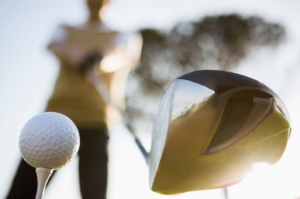You drive me crazy
Related Articles
New rules on reducing the length golfers can hit balls do not go far enough, argue Lorne Smith and John Philp MBE, who state that recreational golfers’ enjoyment of the game are at risk of being reduced while some historic courses are becoming obsolete because they are not big enough.
The ball roll-back and sweet spot debate should be defined by how to improve recreational golfers’ enjoyment rather than the money making ability of vested interests.
This poses the question of whether recreational golfers’ enjoyment can be in line with the interests of the equipment makers and the ‘bomb and gouge’ pros?
This is what the world’s golf rule-makers, The Royal & Ancient Golf Club and the United States Golf Association, have been grappling with and they have been threatening for years to introduce changes to how far a golf ball can be hit.
Why? Very simply, because to really challenge the elite using modern equipment, the courses are having to be built ever longer and the finest and historic courses are becoming obsolete.
The distance issue of course is not new, it goes back to the days of ‘the bounding billie’ following the introduction of the Haskell wound ball around 1900, and it has rumbled along ever since, though now less about how far a ball runs than about how far a ball can be hit through the air.
Two of the greatest ever pros, Jack Nicklaus and Tiger Woods, have been calling for a 15 percent ball roll-back for some time, and Rory McIlroy, the longest driver on the PGA Tour, has now come out in favour of ball roll-back.
It is primarily an elite golfers’ problem rather than the ordinary recreational golfers’ problem, who happen to be around 99-plus percent of all golfers. Tiger Woods has specifically called for equipment bifurcation between elite and recreational golfers.
We think ‘skill and craft’ using strategic positional play or ‘playing the line’ as Old Tom Morris used to call it, is more fun than ‘bomb and gouge’.
The R&A, which leads the USGA in this ball distance area of golf, after years of research concluded that a de-powered ball should be introduced for the elite tournaments to reduce the length a ball is hit by the pros and top amateurs, while letting recreational golfers continue with the present ball.
Many of us have been sceptical as to whether the rule-makers would have the courage to stand up to the money of the manufacturers and the ‘bomb and gouge’ pros.
Unfortunately, this seems to have turned out to be the case.
In The R&A’s consultation, the equipment makers and some of the pros argued against, saying that ‘bifurcation’ was not good for golf.
Have they forgotten that in 2010 bifurcation on pros’ club grooves was agreed and it would be helpful now to be given an explanation as to why ball bifurcation is so bad. Surely The R&A considered all angles before recommending it?
Was a 15 percent bifurcation just an R&A feint in a long-term negotiation with the equipment makers? Or have the rule-makers just caved-in to commercial vested interests?
In response to the equipment makers, The R&A and USGA have announced that new rules will be introduced towards the end of the decade so every ball will be made so it can be hit some 15 yards less by the big hitters (ie five rather than 15 percent less) which we are told will be some five yards less for ordinary golfers.
James Corrigan in the Daily Telegraph wrote recently: ‘Ignore the equipment makers, this historic move will preserve the greatest courses, create a more varied challenge for pros and encourage more people to play.’
In contrast, John Philp MBE, Europe’s leading, living, fine grass greenkeeper, nicknamed ‘The hero of Carnoustie’, and whose 11th hole is now named after, in the same way the 18th at St Andrews Old is named after Old Tom Morris, has given the following quote:
“I fear a five percent reduction in ball distance for the elite won’t make much difference to the many already obsolete tournament venues, especially as implementation is four-plus years away. Fifteen percent reduction for the elite game only I think would be much more effective.
“After all, the distance issue lies with the elite game, not the recreational golfer. Levels of bifurcation exist in other sports like the baseball bat for instance, where an issue between pro and amateur equipment has been addressed.
“So let’s get back to playing ‘real’ golf, the three dimensional game that’s largely been lost from elite television golf. I suggest we need to reign in the elite distance potential by some 50 yards to help restore the challenge of our finest championship courses to be more commensurate with their ability. The current on-going trend is clearly unsustainable in the future.”
Have the ball manufacturers, by using the issue of bifurcation and playing up to the traditional instincts within St Andrews, forced The R&A to create a major increase in ball sales, with all the present balls in practice bags or wherever they are found in the rough becoming obsolete?
I know of many golfers who never buy a new ball. It can be argued that it is only the elite players’ game that is materially changed by using specific balls.
Of course, golf being a game of the mind, the majority of golfers often think they can improve their own game by using equipment to which the pros put their name and a bifurcation might reduce the effect of this marketing technique.
What is undeniably true is that ball sales have always been boosted by the conundrum that golfers want a hard ball, so a driver can hit it further, but also a soft ball, so that it reacts with more control around the green. That dichotomy has been a marvellous marketing boon for golf ball sales down the ages and will continue whatever!
In giving-in to no bifurcation did The R&A then consider they were unable to sell a 15 percent roll-back to recreational golf?
Has this lack of courage on bifurcation neutered the possibilities of an overall change in the game that is effective in protecting the traditional values of golf, which how the elite stars play should epitomise?
The European Association of Golf Course Architects has published a poll of members where 95 percent felt action was needed to reduce hitting distances, 75 percent felt increases in ball flight and equipment advances are diminishing the skill of the game, 80 percent said a reduction of 10 to 15 percent would be appropriate, 34 percent felt it should apply to professionals only, 62 percent thought that amateurs should be spared any regulatory effects and 76 percent thought hitting distances were having a negative impact on golf course design.
Our view is the ‘bomb and gouge’ way of playing has made modern courses less good for the environment and still not long enough for exciting tournament play by the elite.
The basic issue for golfers’ enjoyment, and this is what should drive the issue, is contained in the following and oft repeated refrain that should not be forgotten:
• “The ball should be designed to fit the courses – NOT the courses to fit the ball”; and
• “Skill and craft in winning championships should be that of the golfer – NOT the manufacturer”.
There is another angle to this debate that has now interestingly been raised by The R&A by also announcing, alongside the ball distance change, that the size of the sweet spot of drivers is the next target.
The reason is not clear. Is it another distance thing or is it more importantly associated with re-emphasising the importance of ‘skill and craft’ to a golfer’s enjoyment?
This is a new angle and it is worth considering the history of equipment to help us get the modern prerogatives of the issues around the sweet spot into some context.
There is a growing number internationally of golfers who like to play occasionally with hickory shafted clubs, which everybody did until metal shafts were developed in the 1930s.
Firstly, research has shown that golfers using hickories and a modern ball normally hit the ball about 15 percent less far than with modern equipment. For example, 200 yards rather than 235 yards. Quite often the more forward tees are used and hazards are still in play while the carries are reduced and of course the pace of play is quickened.
With regard to the shorter distance hit by hickories, it is worth mentioning on the other hand what a plus four handicap, 24 year old who borrowed a 1920s hickory driver to play for The R&A’s side in the triangular foursomes match with the British Golf Collectors Society and the home club at Walton Heath in mid July 2022 accomplished. On the 14th on the Old course he drove his modern ball down the slightly downhill fairway, 374 yards and along the flat 16th past the right hand bunker, to 340 yards. The ‘skill and craft’ he showed in hitting the ball straight and running through narrow gaps past the hazards was amazing.
This highlights the real issue of ball distance is less about how far a ball runs than how far it can be hit through the air.
Modern equipment is designed to fly balls further through the air thereby allowing the bomb and gougers to play over hazards, stop the ball on soft fairway turf and be left with a wedge to a soft green. This is about power rather than ‘skill and craft’.
Secondly, for hickories what is more important to The R&A’s issue of sweet spots, is that the best scratch golfers can play with pre-1930s hickory clubs almost as well as with 14 modern clubs and even though they usually have only about seven hickory clubs in their bag.
In comparison, higher handicap hickory golfers need additional handicaps to be added to their normal handicaps to be able to play competitively against players using modern clubs.
Why is this? It is again quite simple. Scratch golfers are used to regularly hitting the ball out of the middle of the sweet spot of any club, while high handicappers only occasionally hit the middle of the sweet spot!
Pre-1930s hickory drivers have tiny heads and all hickory clubs have much smaller sweet spots and are without peripheral weighting, which was invented by Ping some 40 years ago. To play well with pre-1930s hickory clubs relies to a larger extent on the ‘skill and craft’ of the golfer because if the ball is not hit out of the sweet spot it performs some 50 percent worse.
The enormity and construction of modern driver heads still give some 90 percent of performance if hit in the heal or toe, which suggests that there is less ‘skill and craft’ with modern clubs.
Many will think that it is more fun if you can score well and there is no doubt that modern clubs help the golfer to score better, in the same way that receptive greens allow target-golf to make irrelevant the hazards that the high flying hit ball just sails over, with the ball coming to a stop near its pitchmark, and making scoring birdies easier.
This is the two dimensional game of only having to get distance and direction right.
Is it not more fun if you have to take account of the lie of the land and how it influences your running ball on firm turf which is the three dimensional game?
We all want to play well as that is more fun but is this more of an issue of improvement in our game at whatever level we are used to playing? Enjoyment can be had at whatever level if the design and turf of the course are good.
At the end of the day recreational golf is about golfer’s enjoyment and this is enhanced when your pace of play is not held up, you are playing on firm turf, the course is asking you to play imaginative three-dimensional golf and you are relying on your own ‘skills and craft’ both in mental and physical terms.
It is not a question of making golf more difficult for greater enjoyment. But nor is it a question of making golf easier for greater enjoyment.
Sometimes the most fun can be had on a fast running, firm golf course designed by an architect who is of the school of the strategic design of the ‘Golden Age’ architects and where you use your imagination to solve the puzzles that are posed.
Being able to do this with an enormous sweet spot driver and an array of wedges and perhaps the odd six iron as the second shot on a par five, is not where golf wants to go as a mechanism for enjoyment.
John Philp sums up: “Manufacturers and a fair number of professional players seem to have too much influence in the decision-making within the game where money has unfortunately helped erode the true values of golf.”
Lorne Smith is from www.FineGolf.co.uk and John Philp MBE was links superintendent at Carnoustie from 1985 to 2012





























